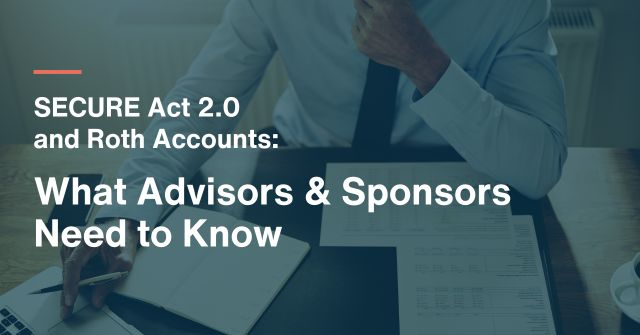Some provisions in the SECURE Act 2.0 have a direct effect on 401(k) and other qualified retirement plans. The provisions outlined below are specific to the “Rothification” of certain retirement plans. These Roth-related features and options—regarding contributions and RMDs—are highly pertinent to plan sponsors and advisors with a retirement plan practice.
- Employer Contributions May Be Treated as Designated Roth Contributions
For qualified 401(k) defined contribution plans, 403(b) plans, and governmental 457(b) plans, participants may choose to treat employer matching and nonelective contributions as designated Roth contributions (if the plan design permits this). Matching contributions made on qualified student loan payments may also be designated as Roth contributions.
To be designated Roth, these employer contributions must be 100% vested and they are not excludable from gross income. This provision became effective for contributions made after December 29, 2022. However, this cannot be implemented without guidance on the employee/employer election process, taxation and reporting, and payroll service and/or recordkeeper’s capability.
- SEP and SIMPLE IRA Plans Have New Roth Feature
Effective for 2023 and later taxable years, employees have the option (if the employer permits) of treating employer contributions to a SEP IRA or SIMPLE IRA as Roth contributions; the same goes for elective deferrals. Prior to the SECURE Act 2.0, only pretax contributions were allowed.
- No More Pre-death RMDs for Designated Roth Account Assets
Starting in 2024, designated Roth account assets in 401(k), 403(b), and governmental 457(b) plans will no longer be subject to pre-death RMD rules.
Guidance for 2023 is as follows: Participants whose first RMD is due in 2023 may choose to take it on or after January 1, 2024; however, they must still include any designated Roth assets when calculating their 2023 RMD.
- Some Catch-Up Salary Deferrals Will be Treated as Roth Contributions
Also effective starting in 2024, certain salary deferral contributions that are considered “catch-up” contributions must be made on a Roth basis for participants whose prior-year compensation from the plan sponsor exceeds $145,000 (indexed). This provision applies to 401(k), 403(b), and 457(b) government plans—but it does NOT apply to “special catch-up” contributions to 403(b) or governmental 457(b) plans.
- Changes to Traditional/Roth IRA Catch-Up Contribution Limits
Catch-up contributions for Traditional and Roth IRA participants age 50 and older have been set at $1000 for many years. This will change next year, as the SECURE Act 2.0 authorizes the IRS catch-up limit to automatically adjust for inflation in increments of $100 starting in 2024.
Additional SECURE Act 2.0 Provision: Increased Catch-Up Contribution Limits
Although not specific to Roth accounts, plan sponsors should be aware that catch-up contribution limits for individuals ages 60-63 will increase over the next two years.
- In 2024, the limit increases to the greater of $10,000 or 150% of the regular catch-up contribution amount, indexed for inflation.
- Beginning in 2025, the catch-up contribution amount for SIMPLE IRA participants will increase to the greater of $5,000 or 150% of the SIMPLE IRA catch-up contribution amount, indexed for inflation.
- As noted above, the SECURE Act 2.0 requires high earners with more than $145,000 in wages to make catch-up contributions only to Roth accounts. Therefore, some employees who are 60-63 years old, who are eligible to make larger catch-up contributions, will have to make them to a Roth account.
If you have any questions regarding these or other changes to qualified retirement plans due to the enactment of the SECURE Act or SECURE Act 2.0, contact your Intac FuturePlan consultant for guidance.

